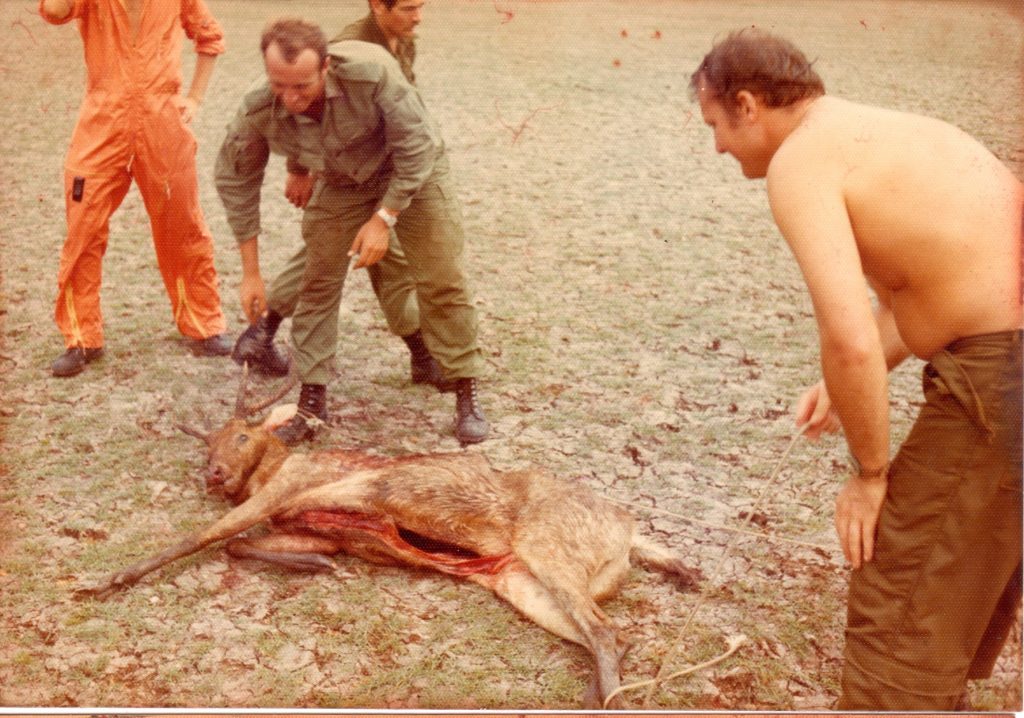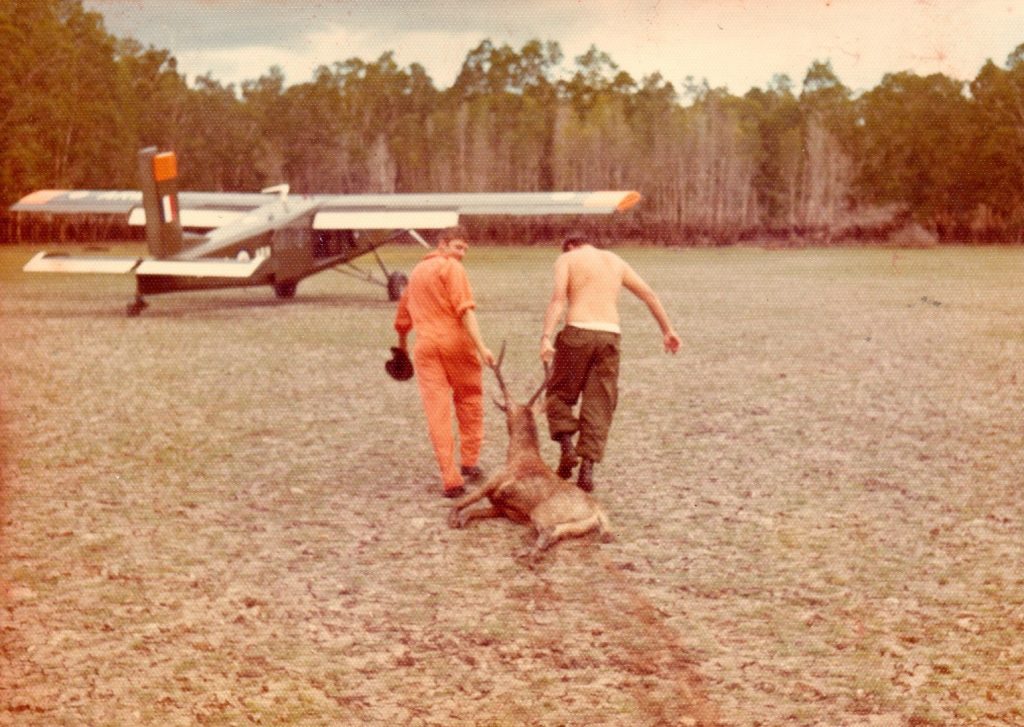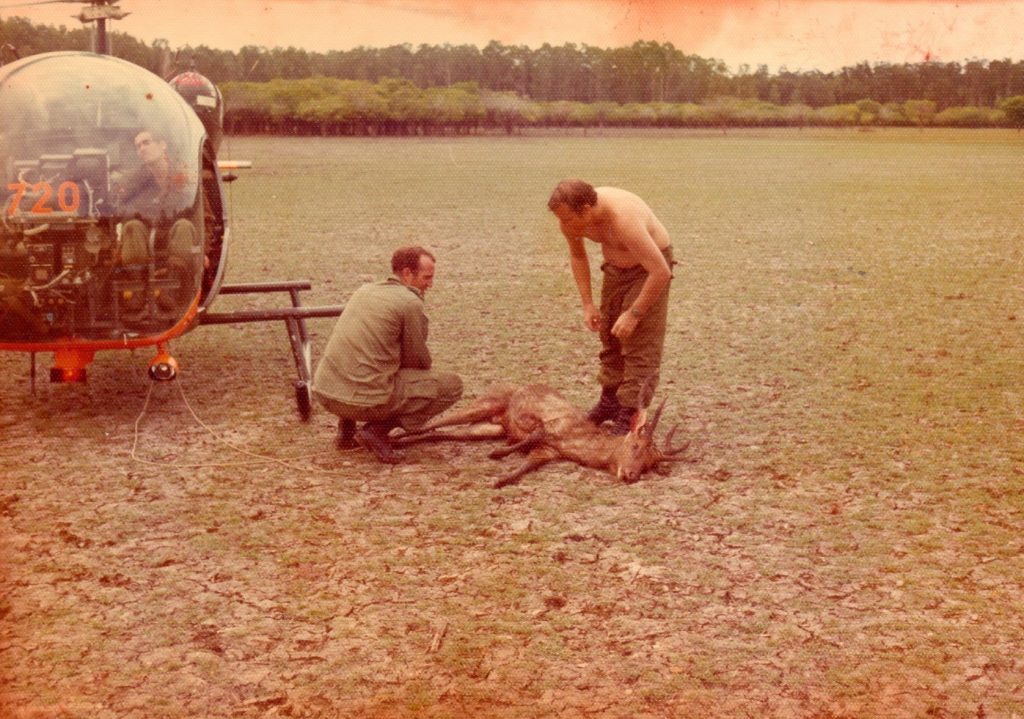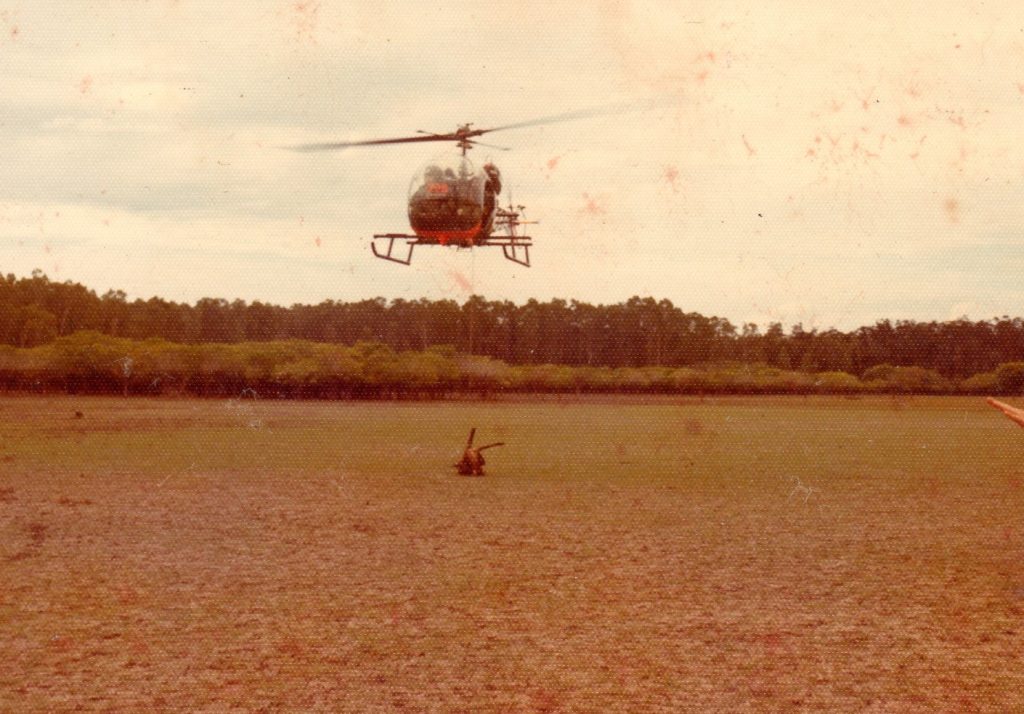The terrible visibility in the Fly River district during 1971 caused a number of problems for the 183 Recce Flight pilots as the smoke from a thousand fires, during the driest spell on record, made navigating in this featureless country near impossible. 2nd Battalion Pacific Islands Regiment were doing a six week intensive patrolling program along the Indonesian border and had a Pilatus Porter and two Sioux helicopters in support. Returning from a visit to a company operating from Lake Murray, about 200 kilometres to the north, I missed our base at Morehead in the one visibility so had no option but to fly direct to the coast and follow the winding river back to the strip. The 30 direct kilometres from the sea to Morehead was increased to about 90 along the winding river. The turbo-prop engine in the Porter was guzzling fuel at 100 feet and I could not see far enough to cut the corners of the river bends. As the fuel totalizer wound back past 9999 I told Colonel Lloyd, the CO, and his Ops Officer that I would put the aircraft in the river if Morehead did not come up before the fuel rang out – better the crocodiles we had seen regularly than the heavy timber. Without so much as a change in expression Col Lloyd removed his peaked cap, undid the leather chip-strap and placed the hat back on with the strap under his chin. He then adopted the position of seated attention as seen in regimental photographs with fists on his knees. After we landed with minus 60 pounds of fuel the CO replaced his chin strap, turned to me and said “Well done Kidby” and left the aircraft. The Ops Officer slunk off to change his underwear.
During this job I encountered the only mutiny from the RAEME crew along with us in my whole time in aviation. There were thousands of deer in the Morehead / Bensbach region and as it was extremely dry they had gathered into herds of hundreds around the remaining waterholes. I suggested to the CO that we should get some venison for the troops (and ourselves) to break the ration pack monotony. Working out we would need to shoot about 30 deer to feed everyone I drew some ammunition and rifles and we set off on the hunt. We found a dry claypan and landed the Porter about 50 yards from a large herd of deer who did not move, standing there like dairy cows as we knocked over about 25 of their number. The three of us (a PIR platoon commander and RAAF crewman off an Iroquois visiting for the day) set about the hard job of gutting and skinning the animals in 30 degree heat. The RAAF sergeant didn’t want to get dirty so after about 2 hours the two of us stood back absolutely covered in blood, fur and flies beside a huge heap of dressed animals. I loaded the first 15 or so carcasses into the Porter and flew back to Morehead. Dave Allan in a Sioux came along and managed to carry the rest slung by ropes under the helicopter. The blood from the animals had run by the bucketful through the floor and down into the back of the Porter and was putrid in minutes in the heat. The RAEME sergeant marched very formally up to me and said “Sir, we are here to work on the aircraft in reasonable manner but this disgusting mess you have brought back in the Porter will not be cleaned up by us.”
“That’s OK sergeant I will clean it up later but only those who contributed to the collection will be getting any venison. You can enjoy a good feed of ration pack tucker for the fourth straight week.” I saw a good size group with buckets and rags at the aircraft about 15 minutes later!




The Hayes Trilogy.
1. The night the low-fuel incident we were sitting in our tent and were visited by our regular group of outstandingly mangy native dogs. These animals were without doubt the worst and most revolting beasts in the world. Terry Hayes who was flying the Sioux, despite his imposing appearance, has a soft heart and was always complaining when the others either kicked these animals or launched the nearest projectile at them. One of the less handsome of the beasts was visibly riddled with worms so Terry decided to become a vet to cure them. He took a cup full of mentholated spirits and doused the rear end of the dog who immediately took off as though rocket propelled, tore around in circles and dropped dead at terry’s feet. There was a feverish rush to bury the dog before its owner, in standard PNG fashion came to claim outrageous compensation for the loss of his champion hunting dog. Terry gave away treating sick dogs.
2 Operating from Saidor on the north coast of New Guinea for a survey party I would fly back and forth each day carrying equipment to a small strip on Lang Island while Terry Hayes in his Sioux did shuttles from the strip to the top of the mountain for the surveyors. Each night we would return with the surveyors and, only having eight people all together in our camp, took turns at cooking, regardless of the rank. It became a bit of a contest to produce gastronomic wonders from the army rations supplemented by locally grown vegetables. Terry who fancied himself as a chef started boasting days before his turn about what a marvellous curry he would cook and all looked forward to this feast. Terry’s secret was the fried rice. On curry day he boiled about 10 kilograms (dry) of rice for the eight of us and laid the cooked rice out on a sheet of tin to dry while we went to work for the day. Cooked and dryed before frying was THE secret. All during the day nobody could talk about anything other than the curry for tea. Late in the afternoon we returned to Saidor and walked down the strip to our camp. Just as we got to the tents we saw a black dog staggering away from the sheet of tin with the last of Terry’s rice falling from its lips. As we sat down to a tin of cold ration pack meat we could hear crashing in the jungle and Terry’s distant voice yelling “Come back here you @#$%^&.”
3. Salamaua is one of the most beautiful spots on earth and can only be reached by a two hour boat trip from Lae PNG. Xmas 1972 a group of five pilots and their wives decided to spend a few days there so, we loaded a huge circus of army tents, food, diving gear, compressors and generators into the army workboat and piled aboard along with our two kids and Dave Griffith’s nondescript dog, Neddy. Dawned Xmas morning and we hired some outrigger canoes from the natives and went paddling over the coral reef waiting until lunch arrived so we could enjoy the feast the wives had made a special effort to produce. Food is often uppermost in Terry Hayes mind and he chattered on about the feast his wife Carol had prepared for him – a whole spiced and basted chicken each! A sight to make a grown man cry met us when we returned to the campsite under the coconut trees – there beside Terry’s open icebox lay Neddy, stomach bulging and the leg of the last of Terry’s chickens actually in his mouth uneaten before he fell asleep. That terry had not nice words to say about Neddy was probably true, that he actually went berserk is only a rumour. Terry and Carol were like two Buddist Monks with their begging bowls at Xmas dinner and neddy never went within kicking distance of Terry ever again.
More Hayes.
I was returning from a job on the Sepik River and had landed at a small mission strip out on the plains where the old Dutch priest told me about the problems they had with a large her of cattle who had gone wild after a failed farming attempt. I volunteered to cull the herd for him and get some meat for the Battalion at Wewak while I was at it. The priest thought if we just knocked over the five biggest bulls he would have some chance of getting them back under control. Next morning the John Salter the assistant ops officer, Terry Hayes and I flew in the Porter to the mission with a rifle and full magazine each. After a long trip across the plains on a trailer towed by a tractor we spotted the herd. Sneaking up over a rise like African buffalo hunters we prepared to shoot with the old priest skulking behind us. The Catholic Bishop of Wewak had heard of the plot and had asked us to bring in a few more beasts for his flock – but not tell the priest as there was some sort of religious debarkation dispute going on! On the word we commenced firing and it was like Custer’s Last Stand. At first shot the herd of about a hundred very large animals, bolted and started racing across in front of the troops who were putting in solid sustained fire. As the priests quota fell to the ground and firing continued he started shrieking in a strong accent “Stop the shooting, stop the shooting!” Just as our revised numbers dropped , and we stopped shooting, the whole enraged herd swang and started charging up the hill towards us in best Western stampede fashion. Suddenly the priest started shrieking even louder “Start the firing, start the firing!’ John Wayne couldn’t have done better and, after the terrified beasts flowed past us, we went down to the horrendous task of gutting 10 large bulls. After the first 3 had been butchered I went back to the trailer to fly the first load back to Wewak. John and Terry, stripped to the waist in the heat, hacking up carcasses with axes, looked daggers at me. Back and forth I flew and on the last load, took John in the front of the Porter and an exhausted Terry Hayes, sprawled out on the carcass of a large bull, in the back. The Battalion Medical Officer condemned the meat as not fit for human consumption and ordered it burnt. This was not good enough, so I took all the carcasses down to the soldiers’ married quarters and we could hear them that night singing as they drank beer and prepared vegetables to go with the meat they were “burning” on the M.O.’s orders.
Bambi Weaver
During an exercise at Wide Bay I had often seen wild pigs on the beach and thought this supply of pork should not be lost so, asked Bambi Weaver to take me in a Sioux to look for a likely animal. Flying along we saw two good size pigs on the beach and Bambi hovered over them and proceeded to follow one who bolted along the waters edge. After about 400 metres the pig got sick of the game and. Completely exhausted, turned to face the helicopter. As Bambi hovered over the panting animal I slid along the skid rack and launched myself into space, landing on top of the startled pig. Unfortunately I had misjudged the height and dropped about 5 metres and lay completely winded on top of the equally winded porker. As we both began to recover the pigs sharp trotters started thrashing and tearing me and my flying suit to shreds. While I was trying to stop the legs, a set of sharp teeth latched onto my foot. Not only was I in a no win situation for letting go or keeping hold, Bambi for some unknown reason, continued to hover over the wrestling match. I still had my helmet on and a storm of sand was being blown under the visor so I could not see while the pig regained it’s strength, alternately chomping on my foot and squealing at 150 decibels. Eventually Bambi landed and e managed to get the large struggling animal onto the skid rack, marginally tied up with our boot laces. Halfway back to camp the pig struggled loose and started to work his way over the edge of the skids. There was no way I was going to allow our hard won pork supply to take a 2,000 foot swallow dive so there was nothing for it but to undo my belt and slide out on top of the pig whose body by this time was hanging out half way in space. The troops say they could hear the pig squealing ten minutes before the chopper arrived and they saw a bloody body in shredded rags laying on top of the hindquarters of a large animal whose front legs thrashed in the air. Help was soon at hand and I staggered off to the medic to have my numerous lacerations attended to. We didn’t even eat him – someone put a rope around his foot and turned him into the flight mascot!
Ian Sinnott
One weekend Terry Hayes, Ian Sinnott and I organised to go crocodile shooting on the Ramu River with a mate of mine who was a professional croc shooter and stuffer. Absolutely armed to the teeth we were dropped off in a Porter by Trevor Wark on his way to a job, with an arrangement to be picked up in a couple of days. Unfortunately our guide’s boat broke down on our way upriver to meet us so we made our way across the Ramu Valley to a cattle property at Dumpu at the wartime Shaggy Ridge strip. We were just in time to join the first round-up of the “weaners” and when the manager asked if we could ride all three very foolishly answered “yes”. Saddled up, we headed out on the plain in the wide Ramu valley and as the day drew on, the new chum’s backsides became more and more painful. I was taking every opportunity to dismount while terry was regularly standing in the stirrups, ostensibly to look for calves in the bushes. Nino just had a twisted expression on his face as he sat bolt upright jarring his spine with every step. Luckily the horses were smarter than us and did all the rounding up required. I can still see Nino’s horse at full gallop trying to cut off a runaway cow with him bolt upright in the saddle, hanging onto the pommel – all thought of hanging onto the reins long abandoned. The manager took me up to the yard where a number of cattle were to be killed (illegally) for the consumption of the local villagers. We volunteered to do the job with our Browning pistols – after all we had to shoot SOMETHING! Just as we had dispatched four nice bullocks the manager saw a car coming and as it drew near he saw it was the dreaded Stock Inspector. As we stood beside the pile of four dead cattle with neat holes between their eyes and a smoking pistol in each of our hands he said, as the inspector drew to a halt, “Act nonchalant!”
